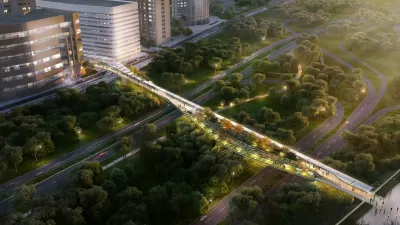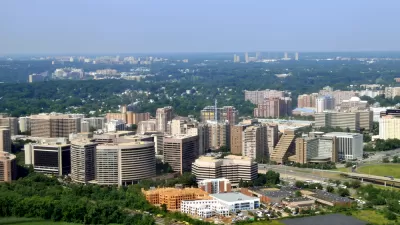The National Landing BID this week launched a "People Over Cars" awareness campaign in response to the Virginia Department of Transportation's plans for Route 1 in Northern Virginia.

Andrew Beaujon reports:
The National Landing BID launched a public-awareness campaign Tuesday about Route 1, the highway that cuts Crystal City off from Pentagon City in Arlington. The campaign is called “People Before Cars” and includes a familiar urbanist wish list: More bike lanes, wider sidewalks, and, perhaps most important, narrower lanes and slower driving speeds.
The BID's vision for Route 1 is presented to counter vision for the corridor currently being circulated by the Virginia Department of Transportation (VDOT), which has been working on plans for Route 1 since Amazon announced it would place its second headquarters in Northern Virginia.
National Landing stakeholders were disappointed in what VDOT presented to the County Board in March, says Tracy Sayegh Gabriel, the BID’s director. The BID wants an “urban boulevard” that doesn’t resemble the current concrete ribbon of Route 1 at all. Some of VDOT’s concepts included three travel lanes in each direction and, as Washington Business Journal reported at the time, “critics believe that vision betrays the community’s goal of a pedestrian-friendly, transit-oriented neighborhood developing around Amazon.com Inc.’s new headquarters.”
Those critics include Amazon's development partner on the HQ2 project, JBG Smith Properties.
Beaujon's coverage of the stewing controversy comes the same week as a presentation by the VDOT on the Route 1 plans to the Arlington County Board. Amazon also recently released a new batch of renderings for the second phase of construction for HQ2. The first phase is already under construction.
FULL STORY: National Landing’s Hopes for a Pedestrian-Friendly Route 1 Could Become a Test of Amazon’s Clout in Virginia

Alabama: Trump Terminates Settlements for Black Communities Harmed By Raw Sewage
Trump deemed the landmark civil rights agreement “illegal DEI and environmental justice policy.”

Planetizen Federal Action Tracker
A weekly monitor of how Trump’s orders and actions are impacting planners and planning in America.

Why Should We Subsidize Public Transportation?
Many public transit agencies face financial stress due to rising costs, declining fare revenue, and declining subsidies. Transit advocates must provide a strong business case for increasing public transit funding.

Understanding Road Diets
An explainer from Momentum highlights the advantages of reducing vehicle lanes in favor of more bike, transit, and pedestrian infrastructure.

New California Law Regulates Warehouse Pollution
A new law tightens building and emissions regulations for large distribution warehouses to mitigate air pollution and traffic in surrounding communities.

Phoenix Announces Opening Date for Light Rail Extension
The South Central extension will connect South Phoenix to downtown and other major hubs starting on June 7.
Urban Design for Planners 1: Software Tools
This six-course series explores essential urban design concepts using open source software and equips planners with the tools they need to participate fully in the urban design process.
Planning for Universal Design
Learn the tools for implementing Universal Design in planning regulations.
Caltrans
Smith Gee Studio
Institute for Housing and Urban Development Studies (IHS)
City of Grandview
Harvard GSD Executive Education
Toledo-Lucas County Plan Commissions
Salt Lake City
NYU Wagner Graduate School of Public Service





























